|
|
|
 |
|
|
|
|
|
No15
|
|
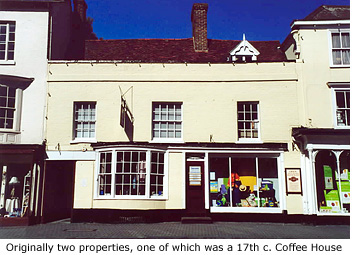 Like the adjacent No 17 (Pearsons) this 17th century building was also originally two properties, one of which is said to have been Bishop’s Stortford’s first and only Coffee House in the early 18th century. Coffee houses first became popular after the Restoration (1660), the city of London boasting 80 such establishments in 1663. An alternative to public houses they were used by all walks of life for social gatherings and, later, as meeting places for commercial dealings. But opening a Coffee House in a town renowned for its malting and brewing industry was a brave venture, so it's not surprising that the earliest reference to this building describes it as an 'inn', and therefore not confined to just the sale of coffee. Like the adjacent No 17 (Pearsons) this 17th century building was also originally two properties, one of which is said to have been Bishop’s Stortford’s first and only Coffee House in the early 18th century. Coffee houses first became popular after the Restoration (1660), the city of London boasting 80 such establishments in 1663. An alternative to public houses they were used by all walks of life for social gatherings and, later, as meeting places for commercial dealings. But opening a Coffee House in a town renowned for its malting and brewing industry was a brave venture, so it's not surprising that the earliest reference to this building describes it as an 'inn', and therefore not confined to just the sale of coffee.
Since that time the property has had various owners. Thomas Page (ironmonger) held it in 1725, and Thomas Pryer (shopkeeper) in 1780. Pryer's widow, Anne, leased it to local auctioneer Peter Ramsey in 1782. When she died the property went to her son, whose heirs sold it in 1811 to J Hodgkins (hairdresser) for £260. He sold in 1823 to Z F Jolley (currier), the property then passing to his widow in 1827, and to their son William in 1833. In 1855 George Edward Sworder purchased it from the executors of William Jolley's will, and when he died in 1884 the property went to his three sons. Henry Sparrow bought it in 1904. His son Alfred inherited it, and when he died in 1971 the property was bought by current owners Pearsons (of Enfield).
|
|
No11
|
|
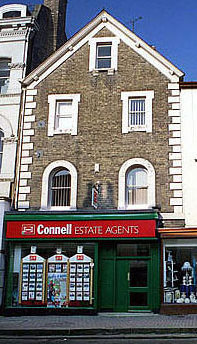 Throughout the 1800s and the early 1900s, this small 19th century building, with its prominent round arch windows at first floor level, had housed a chemists shop. Previous owners included a Mr Morse, Mr Hardy, Mr Ecclestone and a Mr Egbert Cooper. The latter is listed in Kelly's 1910 trade directory as Optician & Chemist at these premises, and also at 12 Potter Street. As was customary at that time, each of these chemists’ dispensed ointments, creams and pills in their own ‘pots’ with decorated lids – items that are now much sought after by collectors. Throughout the 1800s and the early 1900s, this small 19th century building, with its prominent round arch windows at first floor level, had housed a chemists shop. Previous owners included a Mr Morse, Mr Hardy, Mr Ecclestone and a Mr Egbert Cooper. The latter is listed in Kelly's 1910 trade directory as Optician & Chemist at these premises, and also at 12 Potter Street. As was customary at that time, each of these chemists’ dispensed ointments, creams and pills in their own ‘pots’ with decorated lids – items that are now much sought after by collectors.
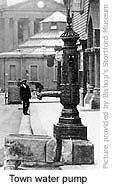 North Street’s water pump and horse trough once stood outside No 11, the pump supplied from a well beneath the road. Regular inspection of the well was carried out via a chamber in this building's cellar, but the passage giving access to it was an evil smelling affair and only the bravest soul would carry out the task. The pump was later moved to New Cemetery at Apton Road, although it has since disappeared. The horse trough is now used as a roadside container for flowers near to the Register office in the Causeway (See Guide 8). North Street’s water pump and horse trough once stood outside No 11, the pump supplied from a well beneath the road. Regular inspection of the well was carried out via a chamber in this building's cellar, but the passage giving access to it was an evil smelling affair and only the bravest soul would carry out the task. The pump was later moved to New Cemetery at Apton Road, although it has since disappeared. The horse trough is now used as a roadside container for flowers near to the Register office in the Causeway (See Guide 8).
|
|
|
|
No7: NatWest Bank
|
|
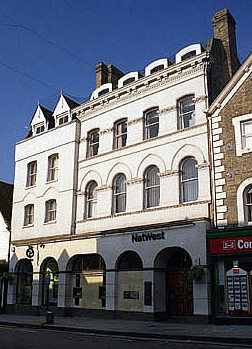 The fact that this bank actually occupies two different buildings – No 9 and No7 – is disguised at ground floor level by a modern stone fascia linking the two. Above this the architectural style of the original buildings can be clearly seen. The fact that this bank actually occupies two different buildings – No 9 and No7 – is disguised at ground floor level by a modern stone fascia linking the two. Above this the architectural style of the original buildings can be clearly seen.
John Wood owned numbers 7 and 9 North Street in 1731. He sold them to a Mr Machin about 1800, then he sold to a Thomas Nottage Millar from whom the trustees of the London County Banking Company bought No 9 in 1867. Mr Millar retained the southern part of the plot (No 7) on which he built the present property and later sold to Bishop's Stortford Urban Council for offices (1895-1920).
These were the years of the town’s annual Whit Monday Horse Parade, a popular event that always culminated with a District Band Competition. Taking it in turns, each band would play while marching between Market Square and Chantry, but to avoid any favouritism in marking their performance, judges sat within the council offices behind drawn blinds.
The London County Banking Company later became the National Provincial bank, then merged with National Westminster Bank to become NatWest.
Some years ago when the bank's store rooms were being expanded beneath street level, a network of passages was discovered. Each was lined with up to twelve open-fronted alcoves the size of a small square room. At the end of one passage was found a set of rusty metal cages and in the cell-like rooms, hooks were attached to the walls. What this catacomb was originally used for isn’t known but it could well have been a prison, an underground hideaway or even an ancient wine cellar.
Local legend has it that it was once possible to walk the entire length of North Street and Bridge Street beneath the pavements, and for this reason the tunnel exits were bricked up soon after they were discovered.
In 1989 the bank commemorated 150 years of its establishment in the town. MORE PICTURES
|
|
|
|
No3
|
|
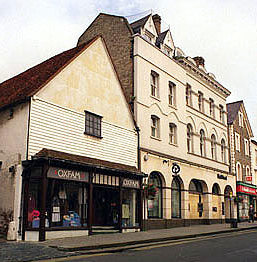 With its high gable and half-timbered frontage this building appears, at first glance, to be a converted barn. It was, in fact, the original stables of the George Inn where horses were kept in the ‘loft’. Entry was via a long ramp at the rear of the building, and when the stable was in use it was a common occurence to see a horse’s head leaning out of the small window just above the shop. A photograph taken in the 1930s, and published by the Daily Telegraph, was of Captain Palmer’s Hunter, ‘Artful Joe’, looking out of the same window. MORE PICTURES With its high gable and half-timbered frontage this building appears, at first glance, to be a converted barn. It was, in fact, the original stables of the George Inn where horses were kept in the ‘loft’. Entry was via a long ramp at the rear of the building, and when the stable was in use it was a common occurence to see a horse’s head leaning out of the small window just above the shop. A photograph taken in the 1930s, and published by the Daily Telegraph, was of Captain Palmer’s Hunter, ‘Artful Joe’, looking out of the same window. MORE PICTURES
|
|
|
|
|
|
|
|
|
|
|
|
|
|
